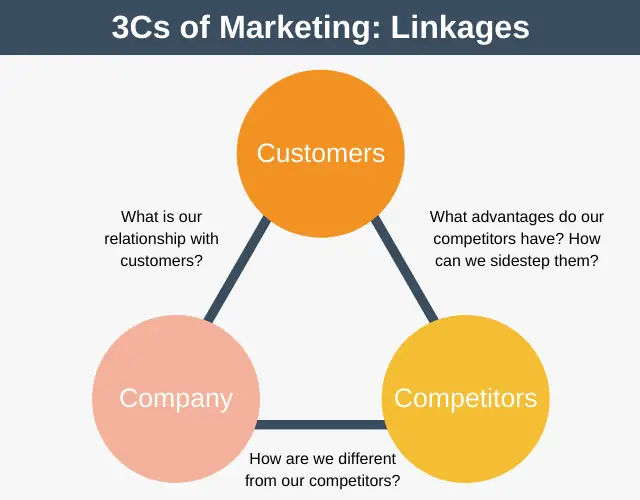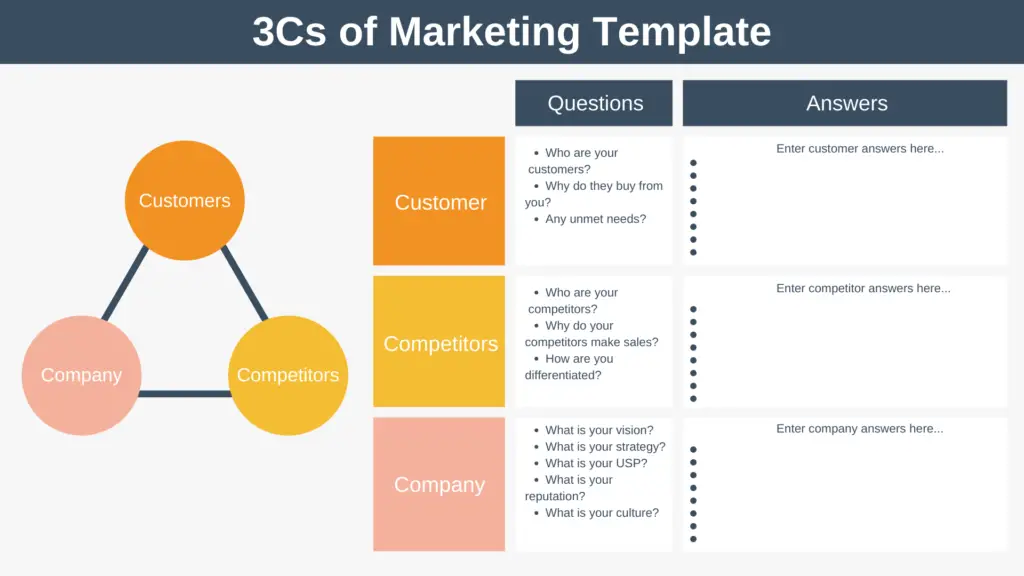The 3Cs of Marketing model is a strategic framework to help you win in the marketplace by better satisfying your customer’s needs than your competitors.
To build a successful business with loyal customers, you must focus on satisfying your customers’ needs. However, you need to do it without forgetting your competitors or your company’s purpose. In other words, you need to use the 3Cs of Marketing.
Background
The 3Cs of Marketing, also known as the Strategic Triangle, was developed by Kenichi Ohmae in 1982.
Ohmae is a Japanese-born organizational theorist, management consultant, and Dean of the UCLA Luskin School of Public Affairs.
The 3Cs of Marketing
The 3Cs of Marketing is also known as the Strategic Triangle because it is often drawn as a triangle, with each of the 3Cs existing in a balance or equilibrium.

Equilibrium means that changing any one of the 3Cs will have a knock-on impact on the other Cs. The model says that when each of the 3Cs exist in an integrated way, you create a sustainable competitive advantage.
Another way to think about the 3Cs of Marketing is in terms of the questions posed by the linkages between the elements.
- Customer-company link: What is our relationship with customers?
- Company-competition link: How are we different from our competitors?
- Customers-competition link: What advantages do our competitors have? How can we sidestep them?

Once you have gathered data for each of the 3Cs, you’ll understand who your customers are, your relative strengths as an organization, and how you can meet your customer’s needs better than your competition. You can then use this information as an input to create your strategy.
Let’s examine each of the 3Cs in more detail.
1. Customers
Without customers, your business would fail. Customers are the reason your business exists, and your primary goal is to serve your customers’ interests.
Do this well, and you’ll create loyal customers making it difficult for your competitors to compete. You’ll have difficulty surviving if you fail to meet your customers’ needs.
To understand your customers and ensure you are customer-centric, you can ask the following questions:
- Who are your customers?
- What are their demographics?
- Why do they buy from you?
- Where do they buy?
- How do they buy?
- How big is the market? How is the market growing?
- Where do customers find the information they need to make a buying decision?
- How do they decide to buy?
- What are the different segments in the market?
- What kinds of customers are the most valuable?
- Can you identify any unmet needs?
- Are customers really satisfied with your product, or could you do better?
Understanding your customers shouldn’t be a theoretical exercise; you need to get out of the office and hold conversations with actual customers to really understand their needs.
Customer Example
Consider the vehicle rental company Hertz. Over 50% of all Hertz’s rentals come from a small subset of their customers: business travelers. Thus, Hertz must deeply understand these customers and their needs to better serve this important type of customer.
2. Competitors
Your customers don’t have to buy from you. They could choose to buy from one of your competitors. For this reason, it’s important to understand your competition.
To understand your competition you can ask the following questions, amongst others:
- Who are your competitors?
- Do your customers buy just from you, or do they also buy from your competitors? If so, why?
- Who will be your competition in the future?
- Why do your competitors make sales?
- Why do your competitors lose sales?
- What are your competitors:
- Goals?
- Strategy?
- Value propositions?
- Capabilities?
- Strengths and weaknesses?
To collect this information, you’ll need to perform research. This might involve conducting a competitive analysis, reading your competitor’s annual reports, talking with your sales team to learn what they hear from customers, or even just researching your competitor’s website.
A key output from this section of the model is to ensure that you are differentiated from your competition.
Competitors Example
Imagine you’re a car insurance company. Your biggest competitor right now might be other insurance companies, but this might not be the case in the future.
The advancement of autonomous self-driving cars may hugely disrupt the car insurance market. What can your organization do to protect itself from this threat?
3. Company
The final C, Company, is all about looking inwards to know who you are as a company and what you stand for. Once you are clear on who you are, you’ll better understand how to stand out from the crowd.
To understand your company, you can ask the following questions:
- What is your vision?
- What is your strategy? Are you going to stand out from the crowd through cost leadership or through differentiation (adding value)?
- What do you do (or what might you be able to do) better than your competitors? You don’t have to be great at everything; you can still win if you can outshine your competitors in one key area.
- What is your USP (unique selling proposition)?
- What will you make in-house, and what will you outsource?
- What is your reputation?
- What is your organizational culture?
- How strong is your brand recognition?
- What are your strengths and weaknesses?
Company Example
Suppose your company strategy is to offer your customers the lowest price. To provide the lowest price means that you need to have the lowest cost base.
If you don’t have the lowest cost base, pursuing a cost leadership strategy is a bad idea. Why? Because what happens when the company with a lower cost base undercuts you? You can’t react and may even go out of business.
3Cs of Marketing Example: Brita
Let’s look at the company Brita, which sells water filters to consumers who want great-tasting water.
Using some guesswork, we will put together a rudimentary 3Cs of Marketing for Britta, starting with their customers.
1. Customer
Most of Britta’s customers are 40-75 years old, but its best buyers are between 60 and 75. Britta’s customers buy from them because they want on-demand clean water in their homes.
Right now, customers buy in-store via retail partners, but this is changing, and increasingly customers are buying online.
Customers have fed back that the easier Britta can make the product to use, the better. New customers can be put off by the high initial price of Britta’s products.
2. Competitors
There are other water filter makers, but Britta has the strongest brand recognition.
New competitors are emerging as the big drinks companies bring out bottled water brands. These competitors offer a product that is both cheaper than Britta’s and more portable.
3. Company
Britta makes easy-to-use water filters for personal and professional use. The company prides itself on creating the best-looking water filters.
From 2010, the company’s focus has been to expand into Aisa, as five of the world’s eight largest water filtration markets are in Asia.
The company’s vision is to offer everyone the best possible drinking water experience according to their individual expectations.
At this point your 3Cs of Marketing exercise might look something like this:

Creating a Strategy for Britta
The 3Cs of Marketing is essentially a data collection exercise. The real power of the model is in what you do with the data you’ve collected to shape your strategy across all 3Cs.
Let’s examine how Britta might do this. By looking at competitor data, we can see that new competitors are offering bottled water, which they are advertising as “pure and natural” water.
Whist the water may be pure and natural, it is being sold in disposable plastic bottles. Britta’s products are all reusable; therefore, there is an opportunity for Britta to bolster its USP by being the most environmentally friendly drinking water in the world.
Any brand selling water in plastic bottles cannot compete with this USP, and so Britta could sidestep their competition by doing this.
Looking now at Britta’s customers. With the growing concern about climate change, advertising their new USP may help Britta’s first-time buyers to overcome the high initial price.
The Company could update its mission from providing the best possible drinking water to include that it provides the most environmentally friendly drinking water.
Before making any changes to its marketing and mission, Britta should test these ideas against existing customers and their target market.
This example has aimed to show how the real power of the 3Cs of Marketing is in analyzing the data to create a powerful yet balanced strategy.
3Cs of Marketing Template
If you’d like to perform your own Strategic Triangle exercise, you can download our 3Cs of Marketing Template here in PDF format.

Advantages & Disadvantages
There are several advantages and disadvantages associated with the 3Cs of Marketing.
Advantages
- It is simple to understand.
- It provides a mechanism to frame strategic conversations with your management team.
- Unlike some models, it provides both internal and external analysis.
- It helps you to understand that you can’t change one of the Cs without needing to update the other Cs.
Disadvantages
- The model is an input to strategy creation, but it doesn’t help you to actually determine your strategy.
- It can take a long time to perform.
- The quality of the exercise is only as good as the data you collect and the quality of the people engaged in analyzing the data.
Summary
The 3Cs of Marketing model is a strategic framework to help you win in the marketplace by better satisfying your customer’s needs than your competitors.
It is based on the idea that there are three elements: customers, competitors, and your company, which must all be in equilibrium to create a differentiated winning strategy.










